I grew up in Dunedin, spent 5 years in Wellington, and am now living in Auckland. Each city is built around a harbour and each offers a spectacular harbour drive. I have driven on these roads on many occasions and in all weathers but have never grown tired of the trips because of the continually unfolding spectacular harbour vistas. Each city is rightfully proud of its harbour drive and is a ‘must’ for any visitor to experience.
 Harbour Vista from Tamaki Drive (mapio.net)
Harbour Vista from Tamaki Drive (mapio.net)
TAMAKI DRIVE AUCKLAND
The 8km (5.1miles) drive from Auckland’s CBD to St. Heliers along Tamaki Drive, is a trip I have never grown tired of doing. The dramatic harbour views first reveal themselves shortly after passing the city’s container terminal on the edge of the CBD. The view across the harbour to Rangitoto is simply breathtaking. I have seen it during a winter storm when the angry grey water was blown across the cycle track which separates the road from the sea wall. I have also seen it on a sunny day when the harbour’s water literally sparkles with millions of luminous spheres. An attractive little marina adds interest to the start of the journey and after turning a few corners and noticing the magnificent pohutukawa trees lining the road, Okahu Bay presents the first of many picture card scenes along this road. This pretty little beach is cradled against a graceful curve in the road.
The city’s famous Kelly Tarlton Sea Life Aquarium is easy to miss as all the action at this popular attraction takes place underground. A little further on, Mission Bay is one of Auckland’s most popular seaside suburbs. The beach is always humming with activity and a row of cafes, restaurants and upmarket apartment complexes give this area a ‘south of France’ feel. The iconic fountain in the reserve on the side of the road is also a popular subject for photographers. The fountain is constructed of Sicilian marble fluted to catch the light and decorated with three bronze sea monsters gushing water. The central jets of water shoot as high as 12 m (40 ft) in the air and at night it features an eye catching light show.
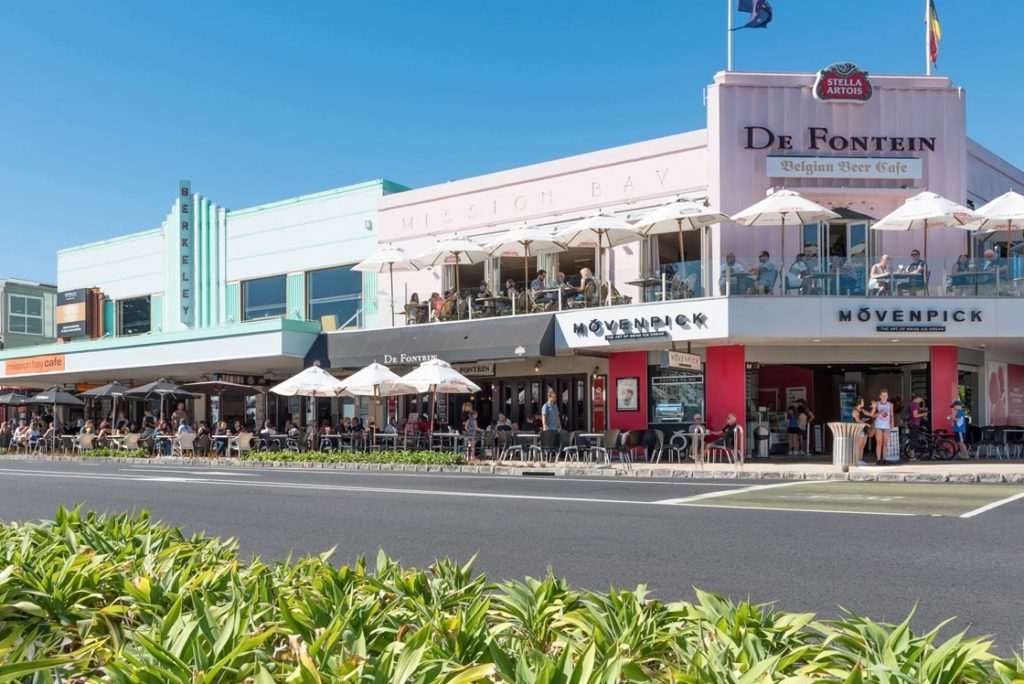 Mission Bay Cafes (missionbay.co.nz)
Mission Bay Cafes (missionbay.co.nz)
Continuing for another 2.5 kilometres from Mission Bay, you reach St. Heliers with its million dollar homes and busy beach. By now, you have been treated to the city’s best harbour views. On the return to Auckland, the city’s office towers stand to attention in a cluster of concrete and glass, with foreground beaches and bays to round off the visual splendour of the city. The beaches along Tamaki Drive are popular all year round but are crowded in the summer months. The pathway that borders the road is popular with joggers and is a great place to see eye candy of both sexes. Cyclists and dogs also jostle for space as they share this scenic exercise strip.
 Cycle Track Tamaki Drive (bikeauckland.org.nz)
Cycle Track Tamaki Drive (bikeauckland.org.nz)
Tamaki Drive is the pride and joy of all Aucklanders and is a ‘must’ to take visitors so they can appreciate how splendid Auckland’s spectacular harbour location actually is.
PORTOBELLO ROAD DUNEDIN
Dunedin is truly blessed to have the Otago Peninsula as part of the city. As a child, my parents would take me and my sister along the winding road to Portobello for an ice cream and a paddle in the harbour.
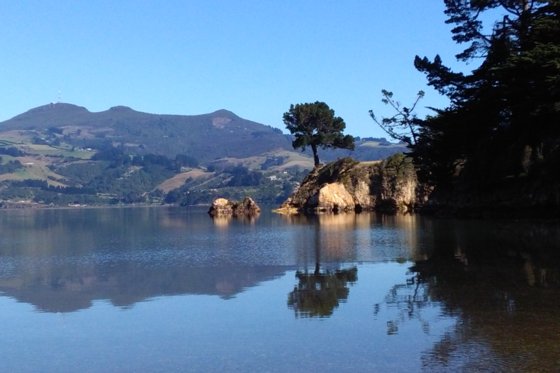 Harbour View from Portobello Road (Ceidrik Heward)
Harbour View from Portobello Road (Ceidrik Heward)
Portobello Road, also known as the ‘low road’ becomes Harrington Point Road past Portobello and terminates at the Royal Albatross colony at Taiaroa Head 33km from the city. Like Tamaki Drive, Portobello Road also clings to a harbour. However, the two roads are totally different in the atmosphere they offer. Tamaki Drive is alive with so much human activity and the harbour is busy with ferries and ships sailing across the expansive water. Otago Harbour is narrow and has little shipping. The road is also less crowded. The seaside suburbs of Macandrew Bay and Portobello don’t have the glitzy apartments either. However, they do have pleasant homes, many set in bush, to add interest to the drive. Before reaching Macandrew Bay, the woodland gardens at Glenfalloch entice you to stop and explore. Macandrew Bay has a cafe and traditional Kiwi convenience store. The little beach is popular in the summer. The view from here looking back up the harbour to the sweep of Dunedin City, is a beautiful vista and popular with photographers.
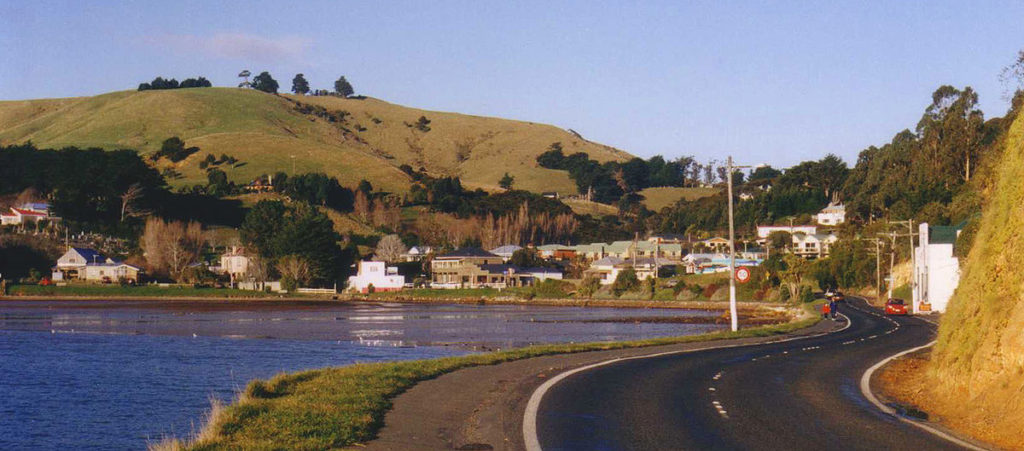 Approaching Portobello (Ceidrik Heward)
Approaching Portobello (Ceidrik Heward)
Eight kilometres from central Dunedin, Portobello is the ‘centre’ of the Peninsula. Otago University has an aquarium here which is open to the public. The outdoor holding pens often have small sharks swimming languidly about. From here, Quarantine Island stands out a short distance from shore. The remains of the double storied wooden hospital building that housed the immigrants that arrived with infectious diseases in the late 1800s, is a prominent landmark. Portobello has a hotel with the only bar on the peninsula. It has the decor of a traditional Kiwi pub and has been a popular place for a few quiet weekend beers while enjoying the peace that Portobello offers. The dairy that sold ice creams to me as a child is still there and hasn’t changed a bit. The ice cream counter is still in the same place right by the door!!
Leaving Portobello, the road soon leaves the side of the harbour and cuts across an area of flat land before arriving at the side of the harbour again at Otakau. This was the first place that Europeans set foot on when sealers set up a processing plant around 1810. Today, a Maori meeting house is the only thing of interest. However, most tourists using the road don’t even know it is there as they climb the steep approach to Taiaroa Head to hopefully see a Royal Albatross. These magnificent birds have established a breeding colony here, the only one on a mainland in the world. The 360 degree views from the heads are spectacular and have become a ‘must see’ to a growing number of overseas visitors.
ICONIC BOAT SHEDS
What makes Portobello Road unique are 43 distinctive boat sheds. They stand over the water in the numerous bays and coves along the road. These attractive little buildings have been a feature of Dunedin since the 1920s. They were built to house the rowboats used for recreation, as well as transport, by the peninsula’s inhabitants. During the 1960s and 70s, their usefulness declined with the falling interest in water based activities. Fortunately, most survived this period and are again prized for their storage capabilities and aesthetic appearance. Over the past few years some have sold for over $40.000!
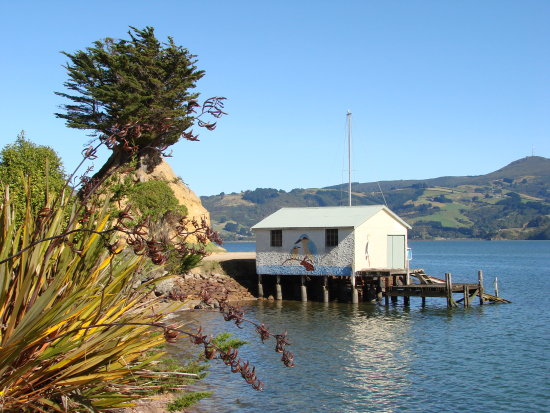 Otago Harbour Boat Shed (Ceidrik Heward)
Otago Harbour Boat Shed (Ceidrik Heward)
Back at Portobello on the return trip, Highcliff Road, also known as the ‘high road’, offers an alternative route to Dunedin. This road provides truly heart stopping views as it carries you over the spine of the peninsula.
On one side, the wide expanse of the Pacific Ocean is jaw dropping. There is nothing between you and South America but the ocean. On the other side of the narrow road, the length of Otago Harbour shows off its beauty in uninterrupted views. It’s hard to keep your eyes on the road as it reveals one magical view after another. New Zealand’s most famous haunted building, Larnach Castle, is reached from this road so it has a high volume of traffic over the various holiday seasons. The view of Dunedin City as Highcliff Road comes to an end, is in my opinion, one of the best urban vistas to be seen anywhere in New Zealand.
EVANS BAY PARADE/ORIENTAL PARADE WELLINGTON
The drive along Oriental Bay Parade to the city is my third favourite harbour drive in New Zealand. Wellington is a very elemental place and I have driven along this road while the agitated, grey sea has been blown over the road, with the wind battering the car. However, on a fine day, the wide body of water is a picture of intense beauty.
Most people travel from the airport via the Victoria Tunnel to central Wellington but they don’t know what they’re missing going this way. The picturesque way to the central city is the coastal route via Evans Bay Parade and Oriental Parade. Evans Bay Parade begins at Kilbernie before turning sharply to follow the contours of Wellington Harbour. The start of the road is not overly exciting but after a kilometre, the harbour views become impressive and by the time the road sharply turns a point and becomes Oriental Parade, the full beauty of Wellington’s location at the head of a wide harbour is eye popping.
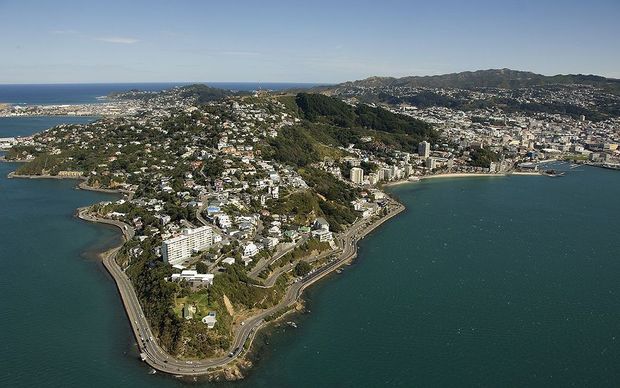 Evans Bay and Oriental Bay Parades (rnz.co.nz)
Evans Bay and Oriental Bay Parades (rnz.co.nz)
On this part of the drive, the central city office towers that line the wide sweep of the harbour, constantly draw your eyes to their gleaming shapes. On the other side of the road, luxury homes sit among the trees on the steep hillside. Oriental Bay is similar to Mission Bay with its glitzy apartments and cafes but being just walking distance from the CBD, it has an urban feel as opposed to the harbour side feel of Mission Bay. The row of pine trees that border the promenade, add a contrasting green to the blue water. The beach here is the most popular in Wellington and one of the best known beaches in New Zealand.
Most New Zealand cities are located on the coast and have their own harbours but none has the spectacular harbour drives that Auckland, Dunedin and Wellington are blessed with. If you plan a holiday to these cities, I urge you to take the time to travel these roads. You won’t be disappointed with the views that have made them so popular with locals and visitors alike.
Ceidrik Heward
Ceidrik Heward is an Amazon TOP SELLING AUTHOR and has lived and worked in 7 countries working as a TV cameraman, director and film tutor. For the past 17 years he has focused on writing and has been published in magazines and newspapers in Europe, USA, Asia and the Middle East.
His interests include photography, psychology and metaphysics. He loves to read and always has at least 3 books on the go. He has written 22 manuals/books and has just completed his 4th short novel. Ceidrik believes sharing information and stories is the best way to stimulate the imagination and enrich our lives.
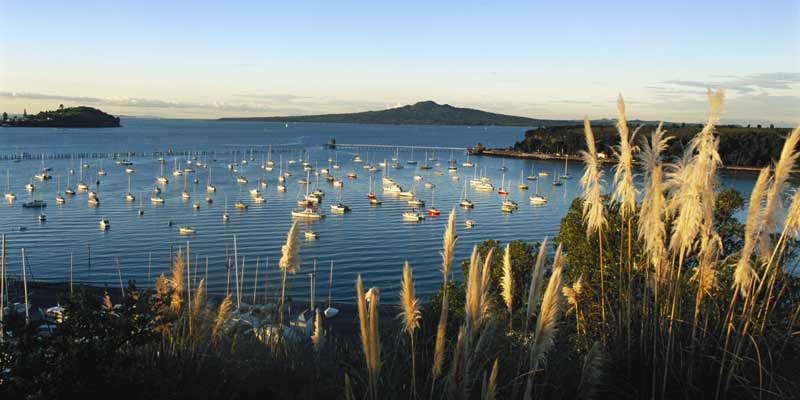
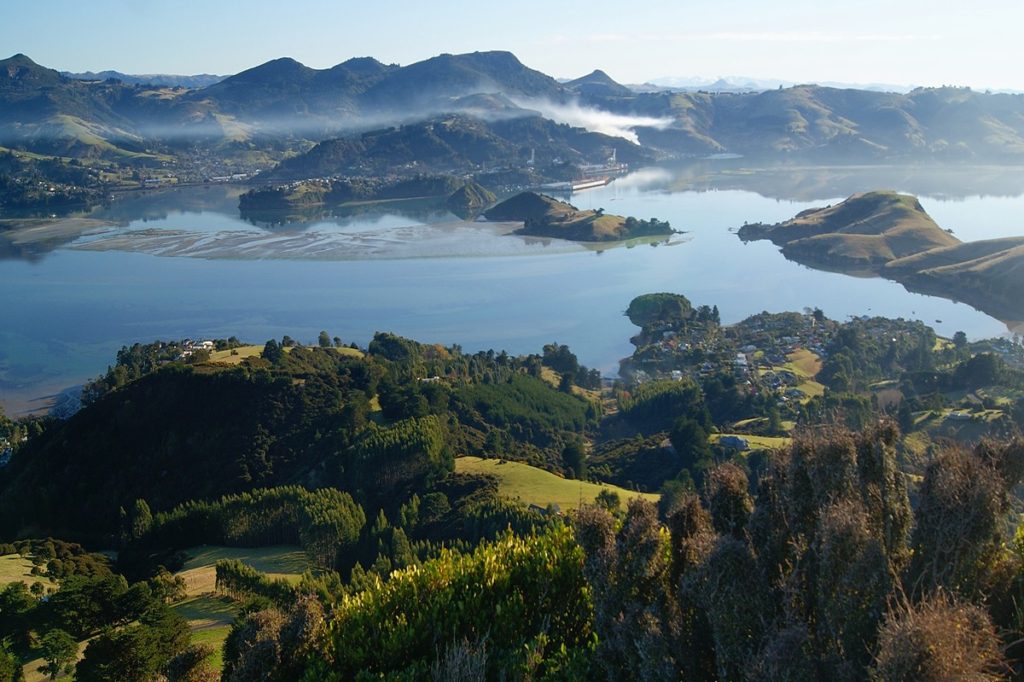



















 Visit Today : 341
Visit Today : 341 Total Visit : 1133518
Total Visit : 1133518
Speak Your Mind